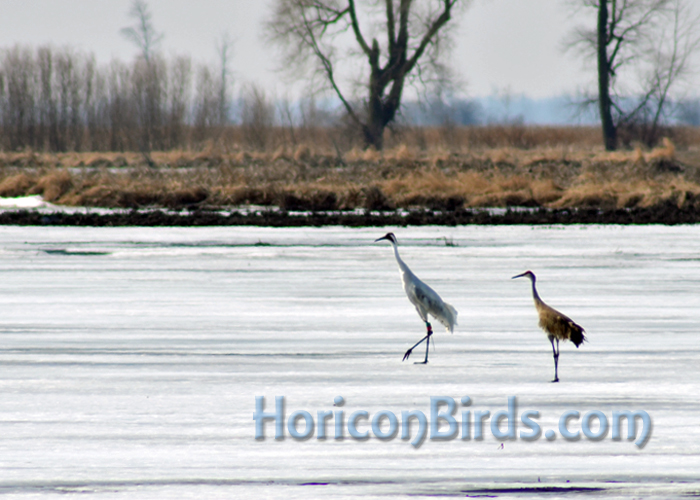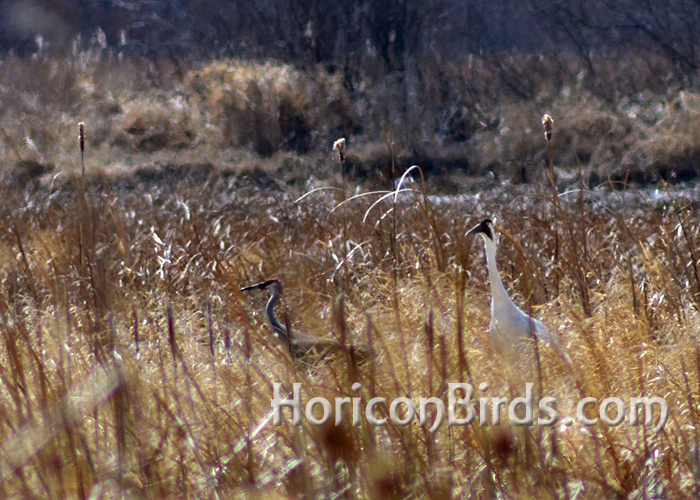|
Nougat (not Grasshopper) returns, following a hard year for DAR birds
by Pam Rotella
8 April 2014
HoriconBirds.com
CORRECTION 1/24/2016: After a request by USGS for clarification on this whooping crane sighting, I scrutinized other old photos of this encounter and discovered that the bird pictured here was NOT "Grasshopper" (16-11) as previously reported, but rather "Nougat" (18-11). In retrospect, this is disappointing news, as Grasshopper has already mated with a sandhill crane to produce a "whoophill." Nougat is yet another DAR-released whooping crane who thinks that he's a sandhill crane and has apparently taken a sandhill crane for a mate. In the story below, I've corrected Grasshopper's name to "Nougat" in most places where Grasshopper appears incorrectly.
HORICON NATIONAL WILDLIFE REFUGE, WISCONSIN - Despite a long, cold winter and ice-covered water, migratory birds are returning to Horicon. A large flock of the marsh's symbol, the redhead duck, gathered in open water on Sunday, while Canada geese, seagulls, red-winged blackbirds, several other duck species, and sandhill cranes were seen throughout the marsh.
|

|
The size difference between whooping cranes and sandhill cranes is apparent as DAR Whooping crane 'Nougat' walks on ice with his sandhill crane companion at Horicon Marsh, 6 April 2014. Photo by Pam Rotella.
|
Parked cars along Highway 49 usually indicate something good to see. With its high speed limit, heavy traffic, and devastating roadkill count, bird watchers need a good reason to tolerate the highway. As birders parked along its shoulders on Sunday, DAR whooping crane # 18-11, named "Nougat," was seen walking on an ice-covered section of the marsh that was home to trumpeter swans and their chicks in previous years.
The return of Nougat is encouraging. Last year, seven of the nine whooping cranes released at Horicon through the Direct Autumn Release (DAR) program were lost.
According to Bryant Tarr, Curator of Birds at the International Crane Foundation, one of the 2013 DAR cranes died from a traumatic event, perhaps a car strike. The other six may have been killed by predators, although the condition of the birds when found made it impossible to know their causes of death with certainty.
Overall, 67 whooping cranes were released by the DAR program since it started in 2005. Of those, 31 are alive today, and the other 36 are dead or long-term missing, Tarr said.
|

|
Nougat flies through the woods at Horicon Marsh, 6 April 2014. Photo by Pam Rotella
|
With slightly more than 400 whooping cranes counted in the wild last year, whooping cranes remain among the most endangered species in North America. Direct Autumn Release is one of several captive-bred reintroduction programs returning whooping cranes to the wild.
Unlike the reintroduction program at White River Marsh, which guides young cranes via ultra-light along a migration route to Florida, or the non-migratory flock in Louisiana, the DAR program expects its flock to migrate, yet offers no direct migration assistance to the young cranes upon release. Rather, its whooping cranes are released into the company of older cranes, usually sandhill cranes, with the hope that young whooping cranes will learn to migrate and be wild cranes by observing older cranes.
|

|
Nougat and his companion land in Horicon Marsh, 6 April 2014. Photo by Pam Rotella
|
Nougat is an older DAR crane, hatched in 2011. And while his return is encouraging, his preference for sandhill cranes is a reminder that the DAR program is only another experiment with whooping crane reintroduction. It remains unproven as a method of establishing a wild and sustainable whooping crane flock at Horicon.
One potential problem with reliance on sandhill cranes is that whooping cranes may imprint on sandhills. This limitation eventually ended the first whooping crane release experiment during the 1970s, where captive whooping cranes were raised by sandhill cranes in Idaho.
Unlike the Idaho experiment, the DAR program doesn't give whooping crane eggs to sandhills to hatch or raise. Rather, whooping cranes' eggs are hatched at a breeding facility and raised by crane-costumed human handlers, as with other costume-reared programs. Then the cranes are released directly into Horicon Marsh, leaving migration assistance to Horicon's existing flock of cranes, almost all of them sandhills.
The whooping crane Grashopper is known for his habit of mingling with Horicon's sandhill crane flock, which could be an indication that he has imprinted on sandhill cranes. Gray areas were seen on Nougat's wings on Sunday, possibly indicating that he had tried to stain his feathers for the summer season, a part of sandhill crane culture.
|

|
Nougat and his companion watch birders from tall reeds at Horicon Marsh, 6 April 2014. Photo by Pam Rotella
|
NOTE 1/24/2016: I originally ended the story like this. Now there are at least two male whooping cranes who think they're sandhill cranes. There will be more to this story as the DAR birds reach maturity. Draw your own conclusions...
Yet other whooping cranes from the DAR program aren't regularly seen with sandhill cranes, which could indicate that they'll eventually take other whooping cranes as mates. Grasshopper may be the only DAR whooping crane with an imprinting problem so far.
Even so, bird watchers adore Grasshopper. The sandhill flock is often accessible, and so is he -- a rare whooping crane making Horicon Marsh his home, because that's where his sandhill flock lives.
All original content including photographs © 2014 by Pam Rotella.
|